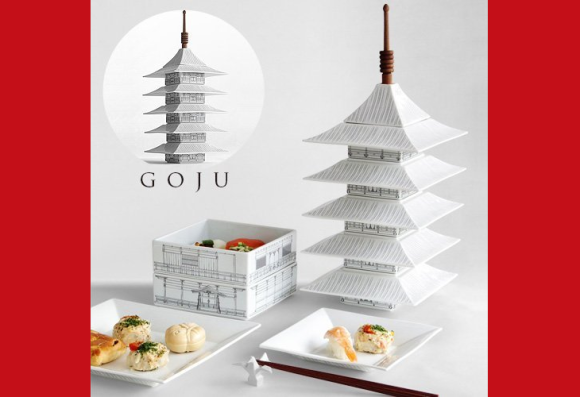
One of Kyoto’s most famous landmarks has been recreated in Hasami-yaki porcelain.
Spotting a pagoda in Japan isn’t such a rare occurrence, as the towers are a pretty common feature of temple architecture. However, five-story-tall examples are few and far between, so much so that the five-floor pagodas in Tokyo, Kyoto, and Hiroshima Prefecture are regular stops on sightseeing tours.
Now you can bring a little of that prestige to your dinner table, with this five-story pagoda-shaped tableware set from Japanese manufacturer Koto.
Called Goju (from goju no to, the Japanese term for “five-story pagoda”), the set is made from Hasami-yaki porcelain. When disassembled, the overturned eaves function as trays, the walls of each floor as box-like bowls, and the uppermost roof as a tapered container. Even the ringed spire at the top of the structure has a purpose, as the walnut circles are also chopstick rests.
The set comes packaged in a paulownia wood box, with a bilingual Japanese/English explanatory leaflet printed on washi paper. Flip the leaflet over, and you’re presented with an aerial view of a Japanese garden on which to place the pagoda.
Ironically, despite the undeniable cachet of the five-story variety in Japan, one of the country’s most famous pagodas has a smaller floor-count. But what Kinkakuji (also known as the Golden Pavillion) lacks in height, it makes up for in historical significance and stately aesthetics, and so it too serves as the basis for one of Koto’s tableware packages.
The Kinkaku set is made from the same porcelain as Goju, but is slightly more varied in the size of its component pieces.
▼ There’s also only a single chopstick rest, but on the plus side, it’s shaped like the phoenix.
The 35,640-yen (US$349) Goju can be ordered here through Amazon Japan, while the 32,400-yen Kinkaku can be purchased here.
Source: Japaaan
Top image: Amazon Japan (edited by RocketNews24)
Insert images: Amazon Japan (1, 2) (edited by RocketNews24)
Follow Casey on Twitter, where he’s wondering if using pagoda-shaped tableware would make it more or less appropriate to build a fort out of your mashed potatoes.

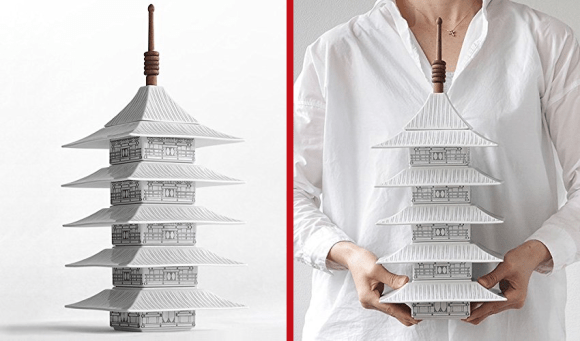
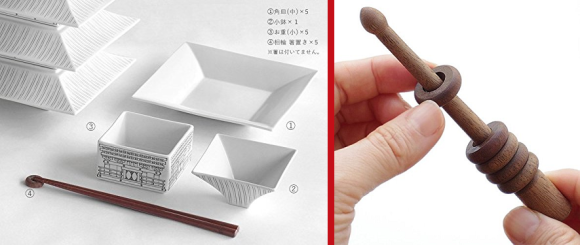
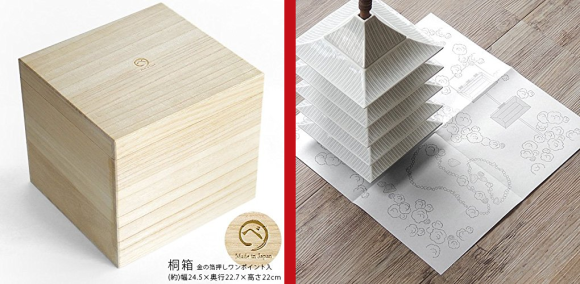

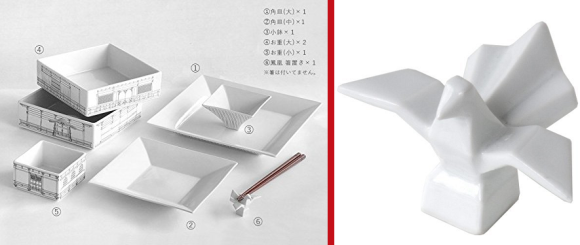
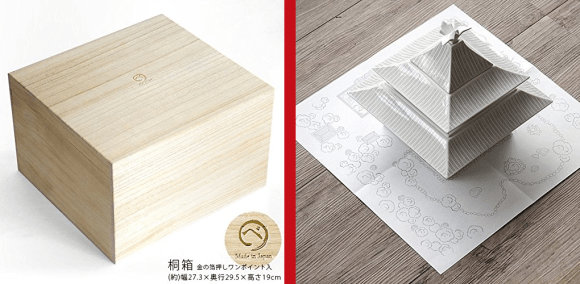
 Traditional Japanese ceramics given new life in AR, delivered straight to your web browser for free
Traditional Japanese ceramics given new life in AR, delivered straight to your web browser for free Add some Ghibli magic to the table with scene-stealing goods from Kiki’s Delivery Service
Add some Ghibli magic to the table with scene-stealing goods from Kiki’s Delivery Service This beautiful video displays two very different sides of Japan【Video】
This beautiful video displays two very different sides of Japan【Video】 Amazing pics from Kyoto/Nara “bullet tour” show no matter how tight your schedule, you should go
Amazing pics from Kyoto/Nara “bullet tour” show no matter how tight your schedule, you should go Japanese-style Rilakkuma teahouse opens in one of the most beautiful places in Japan
Japanese-style Rilakkuma teahouse opens in one of the most beautiful places in Japan Foreigner’s request for help in Tokyo makes us sad for the state of society
Foreigner’s request for help in Tokyo makes us sad for the state of society Japanese city loses residents’ personal data, which was on paper being transported on a windy day
Japanese city loses residents’ personal data, which was on paper being transported on a windy day Historical figures get manga makeovers from artists of Spy x Family, My Hero Academia and more
Historical figures get manga makeovers from artists of Spy x Family, My Hero Academia and more Should you add tartar sauce to Japanese curry rice? CoCo Ichi makes diners an unusual offer
Should you add tartar sauce to Japanese curry rice? CoCo Ichi makes diners an unusual offer Akihabara pop-up shop sells goods made by Japanese prison inmates
Akihabara pop-up shop sells goods made by Japanese prison inmates Mt. Koya planning to instate visitor’s tax to cope with huge tourist numbers
Mt. Koya planning to instate visitor’s tax to cope with huge tourist numbers Seaside scenery, history, and so many desserts on Yokohama’s Akai Kutsu【Japan Loop Buses】
Seaside scenery, history, and so many desserts on Yokohama’s Akai Kutsu【Japan Loop Buses】 Our reporter takes her 71-year-old mother to a visual kei concert for the first time
Our reporter takes her 71-year-old mother to a visual kei concert for the first time Ghibli Park now selling “Grilled Frogs” from food cart in Valley of Witches
Ghibli Park now selling “Grilled Frogs” from food cart in Valley of Witches Red light district sushi restaurant in Tokyo shows us just how wrong we were about it
Red light district sushi restaurant in Tokyo shows us just how wrong we were about it McDonald’s new Happy Meals offer up cute and practical Sanrio lifestyle goods
McDonald’s new Happy Meals offer up cute and practical Sanrio lifestyle goods Japanese ramen restaurants under pressure from new yen banknotes
Japanese ramen restaurants under pressure from new yen banknotes French Fries Bread in Tokyo’s Shibuya becomes a hit on social media
French Fries Bread in Tokyo’s Shibuya becomes a hit on social media Studio Ghibli releases new action figures featuring Nausicaä of the Valley of the Wind characters
Studio Ghibli releases new action figures featuring Nausicaä of the Valley of the Wind characters New private rooms on Tokaido Shinkansen change the way we travel from Tokyo to Kyoto
New private rooms on Tokaido Shinkansen change the way we travel from Tokyo to Kyoto Tokyo Tsukiji fish market site to be redeveloped with 50,000-seat stadium, hotel, shopping center
Tokyo Tsukiji fish market site to be redeveloped with 50,000-seat stadium, hotel, shopping center All-you-can-drink Starbucks and amazing views part of Tokyo’s new 170 meter-high sky lounge
All-you-can-drink Starbucks and amazing views part of Tokyo’s new 170 meter-high sky lounge Beautiful Ghibli sealing wax kits let you create accessories and elegant letter decorations【Pics】
Beautiful Ghibli sealing wax kits let you create accessories and elegant letter decorations【Pics】 Studio Ghibli releases Kiki’s Delivery Service chocolate cake pouches in Japan
Studio Ghibli releases Kiki’s Delivery Service chocolate cake pouches in Japan New definition of “Japanese whiskey” goes into effect to prevent fakes from fooling overseas buyers
New definition of “Japanese whiskey” goes into effect to prevent fakes from fooling overseas buyers Our Japanese reporter visits Costco in the U.S., finds super American and very Japanese things
Our Japanese reporter visits Costco in the U.S., finds super American and very Japanese things Studio Ghibli unveils Mother’s Day gift set that captures the love in My Neighbour Totoro
Studio Ghibli unveils Mother’s Day gift set that captures the love in My Neighbour Totoro More foreign tourists than ever before in history visited Japan last month
More foreign tourists than ever before in history visited Japan last month New Pokémon cakes let you eat your way through Pikachu and all the Eevee evolutions
New Pokémon cakes let you eat your way through Pikachu and all the Eevee evolutions Sales of Japan’s most convenient train ticket/shopping payment cards suspended indefinitely
Sales of Japan’s most convenient train ticket/shopping payment cards suspended indefinitely Sold-out Studio Ghibli desktop humidifiers are back so Totoro can help you through the dry season
Sold-out Studio Ghibli desktop humidifiers are back so Totoro can help you through the dry season Japanese government to make first change to romanization spelling rules since the 1950s
Japanese government to make first change to romanization spelling rules since the 1950s Ghibli founders Toshio Suzuki and Hayao Miyazaki contribute to Japanese whisky Totoro label design
Ghibli founders Toshio Suzuki and Hayao Miyazaki contribute to Japanese whisky Totoro label design Doraemon found buried at sea as scene from 1993 anime becomes real life【Photos】
Doraemon found buried at sea as scene from 1993 anime becomes real life【Photos】 Tokyo’s most famous Starbucks is closed
Tokyo’s most famous Starbucks is closed One Piece characters’ nationalities revealed, but fans have mixed opinions
One Piece characters’ nationalities revealed, but fans have mixed opinions We asked a Uniqlo employee what four things we should buy and their suggestions didn’t disappoint
We asked a Uniqlo employee what four things we should buy and their suggestions didn’t disappoint Princesses, fruits, and blacksmiths: Study reveals the 30 most unusual family names in Japan
Princesses, fruits, and blacksmiths: Study reveals the 30 most unusual family names in Japan Anime taxi cab enters service on streets of Tokyo, just in time for Japan’s biggest manga event
Anime taxi cab enters service on streets of Tokyo, just in time for Japan’s biggest manga event Spirited Away’s No Face appears on new ramen bowls and tableware by Studio Ghibli
Spirited Away’s No Face appears on new ramen bowls and tableware by Studio Ghibli Spoons and bowls that use electricity to make food taste saltier to go on sale in 2023
Spoons and bowls that use electricity to make food taste saltier to go on sale in 2023 Japanese government recommends changing Buddhist temple mark on maps to avoid Nazi connotations
Japanese government recommends changing Buddhist temple mark on maps to avoid Nazi connotations Beautiful Studio Ghibli anime sake flask and cup set lets you get liquored up the Laputa way
Beautiful Studio Ghibli anime sake flask and cup set lets you get liquored up the Laputa way Awesome Pokémon osechi New Year’s meals elegantly blend Japan’s traditional and pop culture
Awesome Pokémon osechi New Year’s meals elegantly blend Japan’s traditional and pop culture Tokyo popup shop sells Japanese indigenous Ainu-inspired tableware for limited time
Tokyo popup shop sells Japanese indigenous Ainu-inspired tableware for limited time Brilliantly designed chopsticks are going to change the way you set the table
Brilliantly designed chopsticks are going to change the way you set the table Giant Buddhist pagoda and Kannon statue in Fukuoka Prefecture look like a theme park
Giant Buddhist pagoda and Kannon statue in Fukuoka Prefecture look like a theme park Doraemon wants to play games, and he’s even bringing his own board!
Doraemon wants to play games, and he’s even bringing his own board! Thermos releases new line of insulated Japanese rice and miso soup bowls【Photos】
Thermos releases new line of insulated Japanese rice and miso soup bowls【Photos】 Unique soy sauce cruet saucer creates beautiful liquid art right on your dining table!
Unique soy sauce cruet saucer creates beautiful liquid art right on your dining table! Totoro, Spirited Away mamezara dishes ready to grace the tables of Studio Ghibli anime fans【Pics】
Totoro, Spirited Away mamezara dishes ready to grace the tables of Studio Ghibli anime fans【Pics】 New stainless steel Pokémon tableware promises to be useful in all sorts of scenarios
New stainless steel Pokémon tableware promises to be useful in all sorts of scenarios Traditional Japanese washi paper features Totoro and friends in 20 beautiful seasonal scenes
Traditional Japanese washi paper features Totoro and friends in 20 beautiful seasonal scenes
Leave a Reply